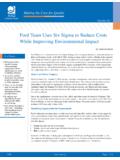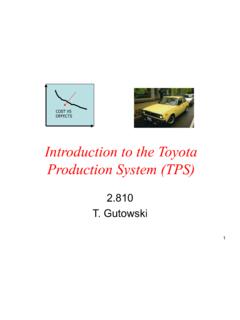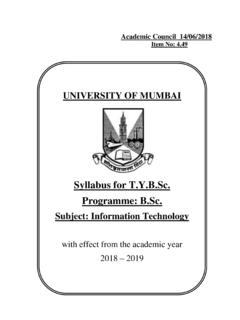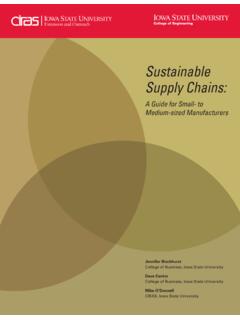Transcription of Material and Information Flow Chart (MIFC) Mapping for ...
1 Material and Information Flow Chart (MIFC) Mapping for lean manufacturing implementation in the D55D Assembly Line 1) Nurul Hayati Binti Abdul Halim 2) Ahmed Bin Jaffar 3) Noriah Binti Yusoff Faculty of Mechanical Engineering Universiti Teknologi Mara, Shah Alam, Malaysia 1) 2) 3) Abstract This research paper is to demonstrate the adoption of the Material and Information Flow Chart (MIFC) in implementing lean manufacturing (LM) at an automotive component assembly line in Malaysia.
2 MIFC is one of the lean tools, also known as Value Stream Mapping (VSM). It is widely used as a framework for systematic and structured improvement activities in LM implementation . In addition, MIFC is a versatile tool to scrutinize in detail relationships between materials and Information flows from the beginning until the end of the assembly process. A case study was conducted at an automotive component assembly line, at XYZ manufacturing Sendirian Berhad.
3 The MIFC was used as a means to map how the materials and Information were delivered along the system, in visualizing the studied area. Findings show that MIFC is an effective tool in identifying wastes and source of the waste, areas for improvement as well as appropriate tools for Kaizen activities. 1. Introduction The process of structuring, operating, controlling, managing, and continuously improving industrial production systems is commonly associated with lean manufacturing philosophy [1].
4 LM is the American term for what is known as Toyota Production System (TPS) [2]. This philosophy is defined as a process of optimizing the existing production activity based on customers need by identifying and understanding the customers values [3]. Hence, it is characterized as customer focused, eliminating waste, creating value, dynamic and continuous [4]. LM was based on Toyota Production System (TPS) which was developed by Toyota.
5 The term lean manufacturing was first coined by John Krafcik in a Fall 1988 article, "Triumph of the lean Production System , and it was popularized by James Womack, Daniel Jones, and Daniel Rose in their book The Machine That Changed the World . Based on this book, the system was then named lean manufacturing [5]. LM or TPS is not new to most automotive components assemblers in Malaysia. They were first initiated by manufacturers from Japan, such as Toyota, Kayaba and Honda.
6 Then, it was followed by local car assemblers such as Proton, Perodua and their suppliers. The reasons why it was applied may vary but it was executed with the same objectives which include on-time delivery, to maintain quality, to increase profit by reducing operations costs and to remain competitive in the local as well as global markets. Concluding, the main goals of LM are cost reduction and improvement of productivity, with focuses on activities such as eliminating waste, reducing inventory and continuous improvement [5], [6], [7], [8].
7 Thus, this research seeks to identify all wastes and source of wastes as classified in the LM philosophy and to implement appropriate lean tools for improvement activities in the D55D assembly line. 2. Literature review In LM, waste is defined as anything related to the process that adds cost but does not add value to the final product produced [9]. Waste elimination is one of the LM s goals and it is believed to be one of the most effective ways to reduce the production cost and increase the profitability of many companies.
8 Some of the examples of wastes elimination activities are elimination of defects, unneeded transportation, waiting time, rejects and non-value-added activities such as rework, recheck and marking process [10], CONFIDENTIAL!11]. To eliminate waste, it is important to understand what waste is and source of the wastes [12]. The seven wastes were initially identified almost 50 years ago by Toyota s Chief Engineer, Taiichi Ohno during the development of the TPS [8].
9 They were classified as: i) transportation; ii) inventory; iii) motion; iv) waiting; v) over processing; vi) over production; and vii) defect. Ohno believed that these wastes account for up to 95% of all costs in non- lean manufacturing environments [5]. This statement was reinforced by the lean Enterprise Research Center, Cardiff, UK, through their research which concluded that, for a typical physical product environment, 5% of the total activities were value-adding activities (VAA), 60% were non-value-adding activities, and the remaining 35% are necessary but non-value adding activities (NNVAA) [1].
10 Since non-value-added activity (NVAA) is a waste, many manufacturers who are aware about this matter strived to eliminate as much waste as possible in their system. The effectiveness of LM is supported by a set of lean tools such as Kanban system, Standardized Work (SW), MIFC/ VSM, Total Productive Maintenance (TPM), Single Minute Exchange of Dies (SMED), Continuous Flow manufacturing System, Kaizen, 5S, Heijunka system and others [13].






